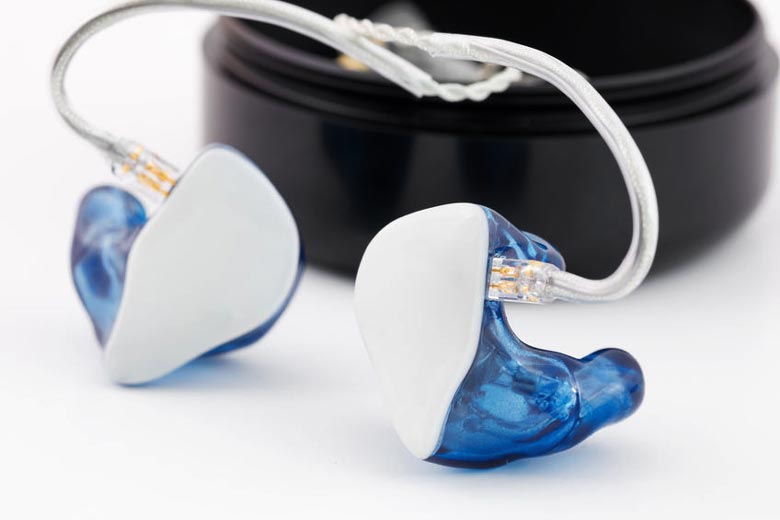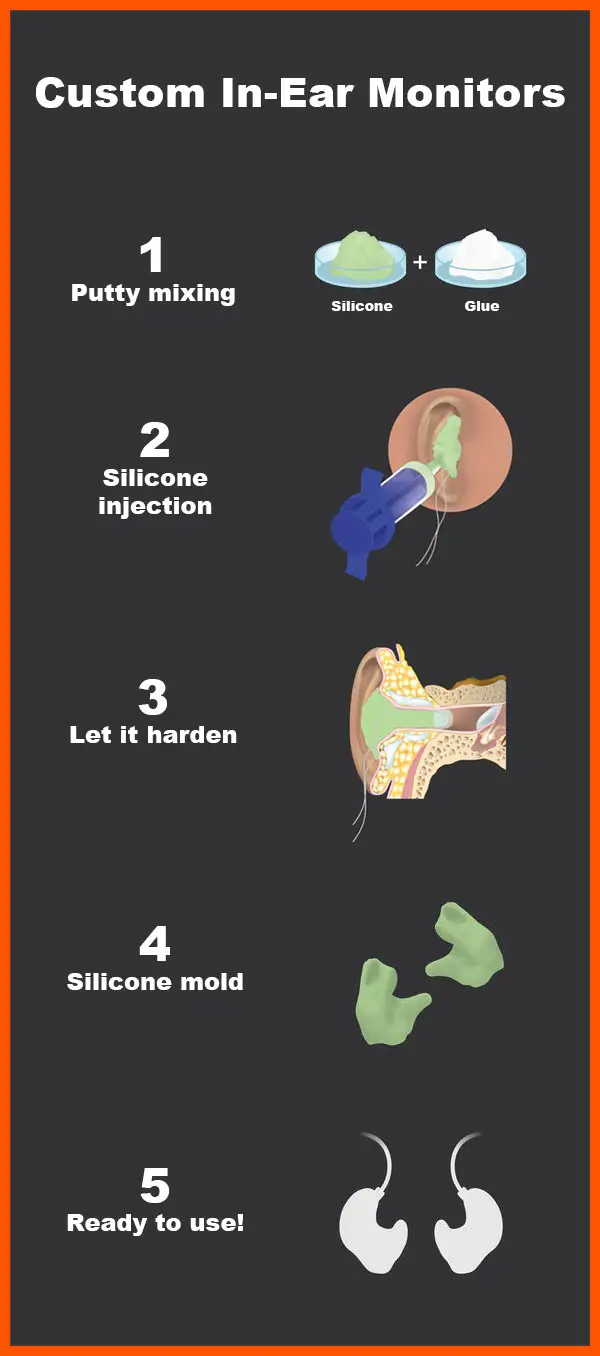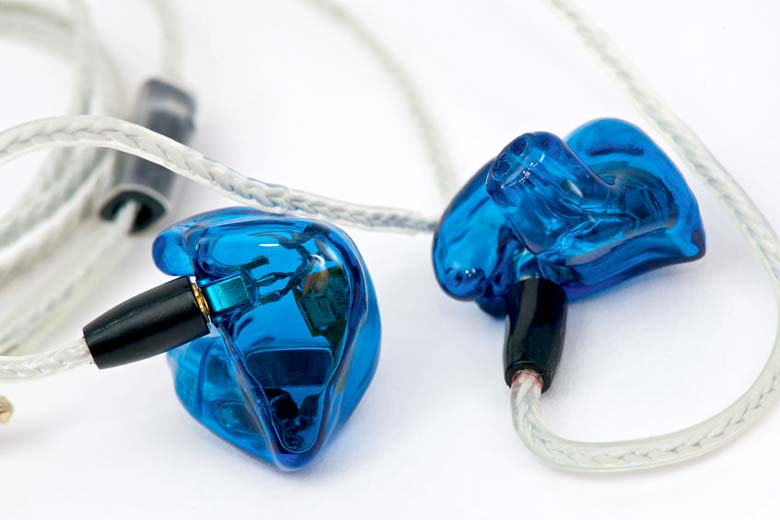Musicians famously prefer in-ear monitors (IEMs), and you’ve no doubt seen countless singers using these oversized earphones on stage. They look almost like hearing aids and connect via a wire to a small transmitter worn on the artist as they perform. But what are they, and how are they different from standard headphones?
IEMs (in-ear monitors) offer high sound quality by isolating the music from the roar of the crowd. As they fit into the ear canal and use more than one amplifier per bud, they deliver much more accurate sound and are used to create personalized monitor mixes by producers and musicians alike.
This article will detail the difference between IEMs and earbuds and explore all the different kinds of IEMs out there. It will also describe the different uses for IEMs, and why some musicians might prefer to not to use them at all.

In-Ear Monitors Explained
On the surface, IEMs strongly resemble headphones with earbuds. In fact, that’s basically what they are! IEMs are advanced headphones that differ from earbuds in a few fundamental ways, which provide musicians with a more honest sound.
Even though IEMs resemble and work like headphones, the technology inside them is significantly different. An IEM will provide a superior listening experience to any set of headphones, especially your average set.
The main reasons for this are how the IEM sits in your ear and the number of drivers in each earbud. Those aren’t the only reasons that professional musicians will prefer an IEM, though. They can be custom-made to create a truly perfect fit with your ears, sealing off outside sounds and preventing them from falling out.
Here’s what makes IEMs such specialized audio tools:
Placed Inside Ear Canal
Earbuds are the tiny speakers that sit at the end of the headphones. They usually have a rubber or plastic tip that fits into the pocket of your outer ear. If you’re used to regular earbuds, you’ll be used to the sensation of them sitting just outside of your ear canal.
IEMs, on the other hand, go a bit deeper and are supposed to be placed into the ear canal itself. This can be a strange sensation to those who aren’t used to it, so don’t worry if it’s uncomfortable at first.
This placement in the ear canal has a few effects on the sound. First, it seals off the sonic data from the earphones from the ambient sounds all around you, in a noise-canceling effect. All you can hear is the isolated sound from the headphones.
Because of this, you don’t have to raise the volume of your music quite so loud to hear clearly.
Without the need to drown out the ambient noise, you can listen at a comfortable volume.
Exposing your eardrums to high decibel sounds is one of the hazards of wearing headphones, so being able to keep the music low is great for longevity. For people who depend on their hearing for their careers, you want to avoid damaging them wherever possible.
Related article: Do IEMs Leak Sound? 4 Important Facts
Greater Number of Drivers
In audio technology, a driver is a transducer, which creates sound waves from electrical energy. On a speaker or studio monitor, the drivers are the circular parts where the sound comes out, sometimes covered in mesh.
On headphones, these drivers are placed inside the earbud itself, essentially making each earbud a mini-speaker.
Earbuds, by and large, will only have one driver per bud. IEMs, on the other hand, will often have several drivers per ear. They can range from having just two drivers on either side to five or six.
Having a greater number of drivers allows each one to focus on a different frequency.
Single-driver headphones will play each part out of the same driver, reducing the sound quality a great deal. A multi-driver earbud will make all the different parts and frequencies much cleaner and more distinct.
That’s a big reason why sound mixers prefer IEMs to regular headphones – it makes it much easier to isolate individual sounds.
If your bass frequency is coming from a completely different sound source than your mids, even if those sound sources are incredibly tiny and close together, you’ll be able to pick out which frequencies the errors are found far easier.
Detachable Wires
Nearly all IEMs will have detachable wires. If you’re used to headphones, you know that your headphones are broken if the bud is separated from the wire. IEMs, on the other hand, can connect and disconnect from the wires themselves with a small plug.
In many cases, they work by operating on a radio frequency to broadcast from the soundboard to the small transmitter.
The real advantage of this is that if you somehow damage your cord—a more common occurrence than you might think—you can replace it without replacing the more expensive earbuds.
IEMs vs. Custom IEMs
If you’re familiar with IEMs, you might have heard about the difference between Custom IEMs and regular IEMs. The former being what you usually see on professional musicians and producers.
They’re significantly more expensive than the average IEM on the market, so only invest in them if you’re sure you will make good use of them.
As the name suggests, custom IEMs are fitted precisely to a person’s ears, so they should never fall out.
They’re made by creating a mold of your ear, then building the earbud itself to your ear and ear canal’s exact dimensions.
You can usually choose the materials its shell is made of, how complex you want its driver system to be, and even how it’s decorated.

Some musicians argue that custom made IEMs are the only “real” kind of IEM when, in fact, there are some major advantages that IEMs have over custom IEMs, beyond their relative cost-effectiveness.
Related Article: Why Are IEMs So Expensive?
One drawback to custom IEMs is that they don’t have a very long life span. Human ears continue to grow through adulthood, so the shape of your ears will change quicker than the rest of your body. That means that your “custom” in-ear monitors will stop fitting so snugly in your ear canal and will fall out quite easily.
Many companies will offer to re-shell the drivers with a new mold or even connect it to a different cable if the original one gets damaged. Again, this can be costly, though it will be significantly less costly than getting an entirely new IEM.
You won’t find true custom IEMs on Amazon, as companies need a mold of your ears to complete an order.
There are many manufacturers out there, and it mostly comes down to personal preference as to which one you want, so do some research and ask your recording artist friends what they think.
Two popular brands are Advanced AcousticWerkes and Ultimate Ears, but there’s no shortage of high-end audio brands that make custom in-ear monitors.
One final note about custom IEMs: be conscious of how your jaw sits as you make your mold. Although you can go to a specialist to have the impression made, some companies will send an at-home kit.
For singers or podcast hosts, for example, you’ll want to utilize the mouth guard, which keeps the mouth open as you make the impression. This will prevent the mold from falling out when you sing or talk.
If you don’t use the guard, you may find that your jaw begins to clench. A custom IEM created with a clenched jaw impression could be painful to use when your jaw is relaxed, making it useless.
If you’re getting your ear impression taken, ask the engineer for the best way to hold your head and face.
What Are IEMs Used For?
IEMs can just be used as high-performance headphones for the average audiophile. They can also be very useful tools for musicians and anyone else in the recording industry.
You might think that their sonic precision simply makes music sound better, but an accurate sound can be indispensable to musicians.

Here are just a few of the reasons that musicians and sound mixers might want to use IEMs—and some reasons they might avoid them:
Personalized Onstage Monitor Mixes
You’ll often see musicians on stage using IEMs in place of floor monitors, which are the speakers you see surrounding the stage. These speakers usually face the musician so that they can hear the music above the sound of the crowd and loudspeakers.
Professional musicians usually choose to purchase custom-made IEMs, which come with a great many advantages.
Additionally, many will also connect to professional soundboards and allow each musician to have their own personalized monitor mix. For example, if the bass player has trouble hearing himself as he stands next to the drummer, an IEM will allow him to hear mainly himself.
These kinds of IEMs are often wireless and will also come with a transmitter, which sends the signals through the UHF band.
Related Article: How To Set Up In-Ear Monitors for Singers
Some musicians prefer not to use IEMs onstage, however. Because of the great seal they provide by working in your ear canal, they tend to shut out any and all surrounding noise. This can be a problem if you move around a lot and are prone to bumping into your stage mates. If you’re using a wireless IEM, you can also run into interference problems with the signal.
When it comes down to it, using floor monitors or IEMs is a matter of preference. As long as you have a way to make sure that you can hear yourself on stage, it doesn’t matter which one you prefer.
Sound Mixing
Sound mixers need specialized tools to hear some of the frequencies they may want to edit. Consumer audio devices won’t always be able to transmit frequencies like sub-bass, which is any noise under 60Hz.
If you’re listening to a track on a surround sound system mixed by someone who couldn’t hear sub-bass, the results may be extremely underwhelming.
Some headphones can transmit these frequencies, but they often use a “smiley face curve” to boost the low end and high end. That’s to improve the listening experience for consumers, who often enjoy heavier bass. Smiley face curves pose problems for sound engineers, however, who need an accurate representation of the recording and all edits they make to it.
Because IEMs are designed for recording artists, they produce a more “honest” sound that doesn’t emphasize any frequency. Sound mixers may want an IEM so that they can get the most accurate sound when they edit their tracks.
IEMs aren’t the only kind of headphones used by recording artists. Many mixers use large over-ear headphones instead. However, these aren’t as convenient for travel, and since IEMs project sounds directly into your ear canal, they don’t have to be turned up quite as loud.
Related article: IEMs vs. Headphones: The Differences Compared
Some people find IEMs and headphones less ideal for mixing, as they can be very harsh and intense. This can make mixers think that some minor errors are much more noticeable than they are and lead to overmixing, which will rob the track of its natural sound.
To avoid overmixing, play the recording at least once through a set of regular studio monitors. That will give you the most even, balanced audio. If you need a basic studio monitor, the Presonus Eris Near Field Studio Monitor is one of the most trusted models out there and won’t break the bank.
Some of the Best IEMs
If you don’t want to invest in a CIEM, but the qualities of an IEM still sound like they would be useful to you, there are plenty of options in a wide range of prices. Regular IEMs will still fit snugly in your ear canal and still have a superior interior tech to even the most advanced earphones.
You don’t need to shell out thousands of dollars to get the benefits of IEMs! Here are some good ones available online, from $20 to over $300.

BASN Musicians’ In-Ear Monitors
This is the cheapest pair of IEMs on this list, proof that you don’t need to get the most expensive model of IEM to reap the benefits. These BASN headphones can transmit frequencies from 20Hz to 20,000Hz, which is essentially the whole human hearing range.
The drawback of these is that they are dual-driver IEMs, meaning they only have two drivers per earbud. That isn’t very many compared to some of the others listed but is still significantly more advanced than your average pair of earbuds.
Keep in mind that if you’ve been listening to music on regular earphones all your life, a dual driver monitor may still sound worlds better!

DCMEKA In-Ear Monitors (with Mic)
These are a very popular pair of IEMs on Amazon and are also some of the cheapest. It’s Bluetooth compatible and also has a detachable wire.
These dual-driver, sweatproof headphones come in three different colors and can come with an optional mic. That makes this one of the best cheap IEMs for working out.

BASN Bmaster Triple Driver In-Ear Monitors
These are also BASN IEMs but feature a total of three drivers on each earbud for a more complete sound. These are slightly sleeker than the cheaper BASN model and come in three different styles: green, gold and black, or sapphire and rose.
It also comes with a woven, detachable cable, which is sturdy against wear and tear.

Better CCA C12 In-Ear Monitor
These CCA in-ear monitors have six balanced armature drivers on each side for a total of 12 drivers. With a zinc-alloy panel and a resin housing shell, it sits comfortably in the ears.
It also has a detachable cable, which you can replace if the original gets damaged.

Erjigo KZ-AS12 In-Ear Monitors
These erjigo devices also have six drivers on each side and support HiFi Stereo audio. With a detachable cable, these IEMs come in cyan or black.
The sleek design of these makes them great for sports use if you want to experience high-quality audio while running or playing tennis.

Moondrop Blessing2 In-Ear Monitor Silver
These monitors have five drivers on either side and, are one of the most expensive pairs on this list. It’s still hundreds of dollars less than your average CIEM, so it makes a good middle ground for people on the fence.
These headphones are amazingly clear, and they come in a wide variety of colors and designs.
Final Thoughts
IEMs are a common tool for sound mixers, performing artists, and other people in the recording industry. They’re used to help musicians hear themselves on stage and to help sound mixers get an accurate sense of how a recording sounds so they can edit it.
Some musicians and mixers prefer floor or studio monitors to an IEM so that they aren’t overwhelmed by the isolated noise in their ear canal.
For people who want to get an authentic audio experience for any reason at all, IEMs are a great place to start.